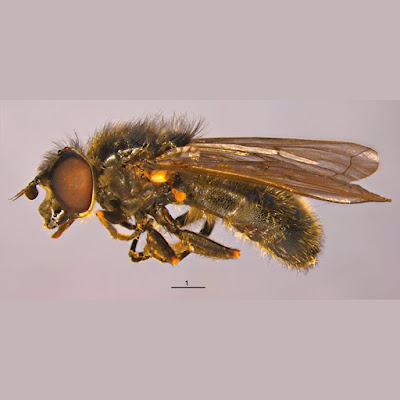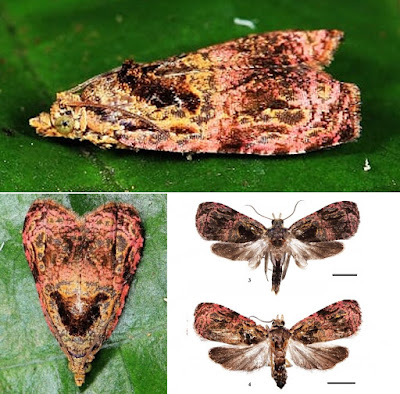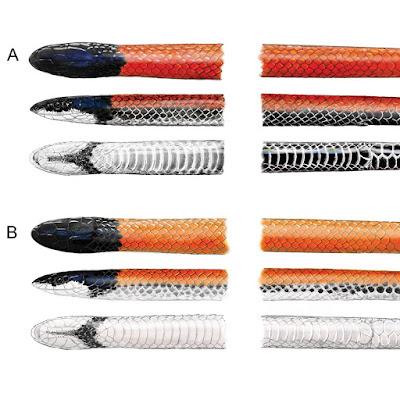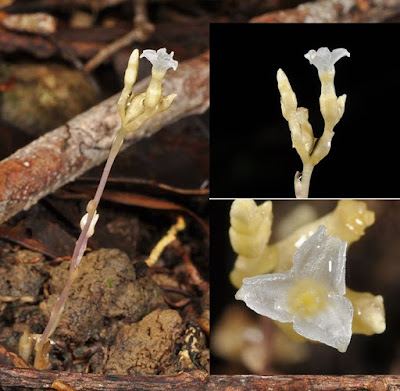[Most Recent Entries] [Calendar View]
Tuesday, April 30th, 2019
| Time | Event | ||||||
| 2:09a | [Entomology • 2019] Katara connexa • Hidden European Diversity: A New Monotypic Hoverfly Genus (Diptera: Syrphidae: Eristalinae)
Abstract For the first time in more than 30 years, a new European hoverfly genus has been discovered, Katara gen. nov. Its type species Katara connexa sp. nov. (Diptera: Syrphidae) is described from the Pindos Mountains (Greece), and the systematic position of the monotypic taxon within the tribe Rhingiini is analysed using morphological and molecular data. Phylogenetic analyses resolved Katara connexa gen. et sp. nov. as sister taxon to Pelecocera latifrons. We assert based on the molecular phylogenetic results and the morphological distinctness of Pelecocera latifrons that this taxon merits a generic rank, thus we erect the genus Pseudopelecocera gen. nov. and also place Pelecocera persiana in this new genus based on shared characteristics. Based on our results, we place Chamaesyrphus in subgeneric rank and as a sister group to the nominal subgenus Pelecocera. We provide an identification key to the Rhingiini genera. Our phylogenetic analyses recovered all speciose Rhingiini genera as monophyletic and support existence of three main lineages within the tribe: (1) genus Rhingia with two groups, Palaearctic+Neotropical and Afrotropical taxa, (2) genus Cheilosia with its subgenera, and (3) lineage with remaining genera (Pseudopelecocera gen. nov., Katara gen. nov., Ferdinandea, Psarochilosia, Psarus, Portevinia and Pelecocera). Keywords: Katara connexa, new genus, new species, Pelecocera latifrons, Pindos Mountains, Pseudopelecocera
Family Syrphidae Latreille, 1802 Tribe Rhingiini Meigen, 1822 Genus Katara Vujić & Radenković gen. nov. Etymology: The new genus is named based on type locality, an area between Katara pass and Kampos Despoti, in PindosMountains, central Greece. Word ‘Katara’ is latinized from the Greek word ‘Kataras’. The name is to be considered as feminine. It means ‘curse’ in Greek language, indicating the dangerous high mountain pass. Katara connexa Vujić & Radenković sp. nov. Etymology: The new species is named according to the Latin word ‘connexa’ indicating the connection of the taxon to the other taxa of the tribe based on its characters. It is the participle of the verb ‘connecto’ in the nominative singular and agrees in feminine gender with the corresponding genus name. Ante Vujić, Gunilla Ståhls and Snežana Radenković. 2019. Hidden European Diversity: A New Monotypic Hoverfly Genus (Diptera: Syrphidae: Eristalinae: Rhingiini). Zoological Journal of the Linnean Society. 185(4); 1188–1211. DOI: 10.1093/zoolinnean/zly066 | ||||||
| 5:18a | [Entomology • 2019] Theorica valuliae • the First Record of the Genus (Lepidoptera: Tortricidae: Olethreutinae) in Thailand
Abstract The genus Theorica Diakonoff, 1966 includes two previously described species that occur in Vietnam (i.e., T. secunda Kuznetsov, 1997) and New Guinea (i.e., T. lamyra (Meyrick, 1911)). We report the first occurrence of this genus in Thailand, represented by a new species: Theorica valuliae Pinkaew, n. sp. In addition to illustrations of the adult and genitalia, we also present photographs of living specimens in their natural resting posture. Keywords: new species, taxonomy, Olethreutini, Thailand, Lepidoptera
Theorica valuliae Pinkaew, n. sp. Diagnosis. The male of this species is most similar to that of Theorica secunda Kuznetsov in having a modified hindwing with a tube-like anal lobe separated from the anal margin at the base of the wing. The two species differ in the ground color of the forewing: grayish brown in T. secunda and pinkish red in T. valuliae. The male genitalia of T. valuliae are most similar to those of T. lamyra (Meyrick, 1911), but the socii are covered with twisted setae in T. valuliae and straight setae in T. lamyra. The female genitalia of the new species is distinct from other species by having a very short ductus bursae with the corpus bursae reaching only slightly beyond the anterior margin of sternum VII. Moreover, the moth in resting posture has a distinct heart-shape and a dark brown V-shaped mark crossing both wings (Fig. 2). .... Etymology. The specific epithet is a patronym dedicated to the late Associate Professor Valuli Rojanavongse, who served as the Master's degree advisor for the first author. Distribution. Thailand. Specimens were collected in both natural forest (evergreen and dry evergreen forest) and reforest areas. Nantasak Pinkaew and Sopita Muadsub. 2019. Theorica valuliae Pinkaew, new species (Lepidoptera: Tortricidae: Olethreutinae), the First Record of the Genus in Thailand. Zootaxa. 4590(4); 487–494. DOI: 10.11646/zootaxa.4590.4.5 | ||||||
| 7:39a | [Herpetology • 2019] Taxonomic Status of Apostolepis barrioi Lema, 1978, with Comments on the Taxonomic Instability of Apostolepis Cope, 1862 (Serpentes, Dipsadidae)
Abstract Apostolepis is a diverse neotropical snake genus, which has been historically subjected to poor taxonomic descriptions, largely based on either a small type series or subjective diagnoses. We evaluate the case of Apostolepis barrioi Lema, 1978 and its intricate taxonomic history, suggesting its synonymization with Apostolepis dimidiata (Jan, 1862), and providing brief commentary on the taxonomic instability that has been plaguing the genus. Keywords: Elapomorphini, Neotropical, synonymy, taxonomy Omar Machado Entiauspe-Neto, Arthur de Sena, Arthur Tiutenko and Daniel Loebmann. 2019. Taxonomic Status of Apostolepis barrioi Lema, 1978, with Comments on the Taxonomic Instability of Apostolepis Cope, 1862 (Serpentes, Dipsadidae). ZooKeys. 841: 71-78. DOI: 10.3897/zookeys.841.33404 | ||||||
| 4:55p | [Botany • 2019] Gymnosiphon philippinensis (Burmanniaceae) • A New Species from Cebu, Philippines
Abstract Gymnosiphon philippinensis is described as a new species of Burmanniaceae from forest over limestone in southern Cebu (Philippines). Among Malesian Gymnosiphon, it is most similar to G. papuanus and G. pauciflorus in having flowers with stamens that are attached in the middle of the floral tube and having outer tepals with entire margins, but these tepals are longer in absolute and relative lengths than those of the aforementioned species. Gymnosiphon philippinensis is the first species of Gymnosiphon reported from the Philippines. Keywords: Achlorophyllous mycoheterotroph, Alcoy, Nug-as, saprophyte, taxonomy, Monocots Gymnosiphon philippinensis Pelser, Salares & Barcelona sp. nov. |
| << Previous Day |
2019/04/30 [Calendar] |
Next Day >> |


















